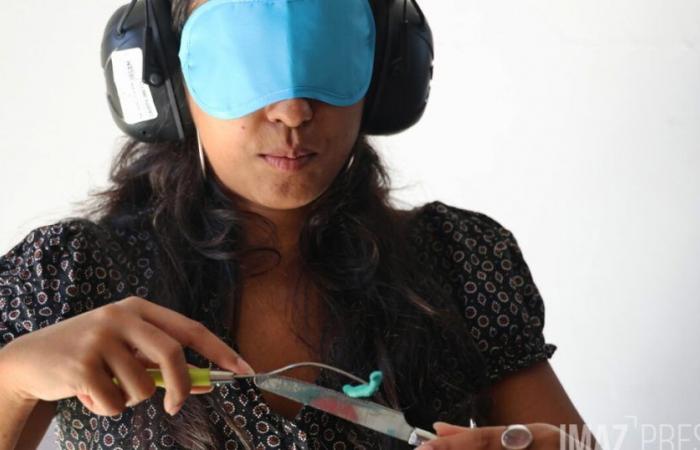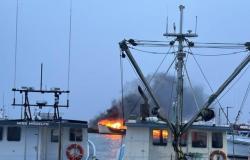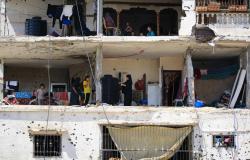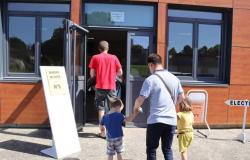This Thursday, June 27, 2024, the Rare Disabilities Relay Team (ERHR) Réunion-Mayotte organized the first World Deafblindness Day at the Académie des Camélias in Saint-Denis. During this event dedicated to people with visual and hearing impairments, the IRSAM Association organized a “yarn bombing”, a practice consisting of covering street furniture with knitting of all colors. Various workshops to raise awareness of deafblindness were offered to the public. Imaz Press was also able to put itself in the shoes of a person with this disability (Photo: sly/www.imazpress.com)
Arriving in one of the rooms of the Camélias academy, the IRSAM team offers several fun activities on the theme of deafblindness. One of the workshops suggests putting on a construction helmet and then vision-disrupting glasses to reproduce the aspects of cataracts.
With impaired and blurred vision and muffled surrounding sound, we are ready to try to complete the small missions given by IRSAM and discover the daily life of a person with deafblindness.
First objective, to be able to read the instructions written on a small piece of paper. No easy feat when your eyes only show a black and compact shape for each word. The trick is to turn the sheet in front of your eyes, a little in all directions, to decipher the sentences. Instructions read not without difficulty.
In this other workshop, several sardines are drawn next to each other with an accessory or item of clothing specific to each. Like “Where’s Waldo?”, the difficulty lies in the ability to differentiate each of them to find the one you are looking for.
Here again, it is better to bring your eyes closer to distinguish the tie from the scarf or the dress from the jacket. If the first sardine gave us trouble, the others were done more quickly, even if we had to redouble our efforts and concentration to find the right one.
Another exercise, that of weights, where you have to group together in pairs those that have the same weight. A workshop that calls on touch and a game of balance with your hands, and which turns out to be just as difficult without a disability. A semi-success: we failed to group together 4 of the 8 pairs of weights.
The last exercise is done with your eyes closed, to reproduce a case of total blindness. A word is given, and it must be reproduced with 3D letters. As with the previous workshop, you have to use touch to find which letter is in your hands. So it’s letter by letter, using your fingers to manipulate consonants and vowels to find the ones you need.
We were tasked with reproducing the word “table”, and it was flawless!
The aim of these workshops: to show that a vision disorder increases the concentration needed to decipher a word or a shape. Total blindness, on the other hand, calls on other senses such as touch. By adding hearing impairment, there is a feeling of being left to oneself where external help cannot be oral. A feeling of fatigue takes over where the slightest gesture or movement calling on these senses increases the slightest effort tenfold. A very good way to raise awareness among the general public.
– Technological innovations to make life easier –
“These workshops allow us to open the field of disability to the public to show that there are things that are being put in place and innovations,” underlines Guillaume Kichenama, elected delegate for disability and the fight against discrimination in the city. from Saint-Denis.
“It’s up to us to adapt to this inclusive city where no one is excluded from leisure and happiness,” he adds. look
Tools to make life easier for people with vision or hearing problems are found in abundance in the IRSAM truck, run today by Christophe Lebon, coordinator of the system. Converted into an office, this vehicle goes around the island in order to “have equipment tested by people with disabilities”, he explains.
“With a virtual reality headset smartphone, we will have a simulation of visual pathologies. We support people on trips such as going up or down stairs,” explains Christophe Lebon.
Connected vibrating alarms, audio description applications, several devices are designed to avoid certain daily hassles. Having a problem getting up in the morning? A vibrating alarm clock placed in the cushion. Phone call ? Your smartphone is connected to a vibrating box. And this system works for other scenarios like someone ringing your doorbell to a fire breaking out in your home.
“We show that digital and technological solutions exist and that things accessible to an average person are also accessible to a person with a disability,” says the coordinator of this system. look
– What is deafblindness? –
Deafblindness is a specific sensory disability that is highly isolating and results from a combination of hearing and vision loss or impairment. It significantly affects communication, socialization, mobility and daily life.
Josian, pre-retired, has retinitis pigmentosa on the side of his eyesight, and for a year and a half, has been affected by deafness. He now uses hearing aids and is learning to move in space with a locomotion instructor.
“The team of professionals at SAMSAH (Medical-Social Support Service for Disabled Adults) in Saint-Louis allowed me to come out of my bubble and today I am a little more open and express myself easily,” says Josian. look
June 27, chosen as World Deafblind Day, is an international event initiated by DeafBlind International to pay tribute to the birthday of Helen Keller, a famous American author and activist who became deafblind as a baby.
“With this day, we want to raise awareness of the need for adaptation in all spaces in terms of communication, particularly for people who are deafblind,” says Hélène Salez, head of the ERHR.
– Call the ERHR: a free service –
People with disabilities, caregivers, families, relatives or medical staff can contact the Rare Disability Relay Teams (ERHR), supported by IRSAM, to find solutions in their living areas. “If the assessments of the person concerned are sufficient and a rare disability qualification is made, an intervention plan is proposed,” explains Hélène Salez. Their services are free and accessible without MDPH notification.
“The particularity of rare disabilities is a combination of severe deficiencies which means that medical establishments do not have all the answers in terms of support,” she says. look
The public was able to attend a free conference and a round table on the subject of deafblindness in the morning. In the early afternoon, the atmosphere was ensured by a concert by the event’s patron, Davy Sicard, in the Camélias amphitheater. He was accompanied by the artists “autrement associés”, young musicians adept at maloya who are visually or hearing impaired.
dm/www.imazpress.com/[email protected]
News from Reunion, Saint-Denis, Disability






